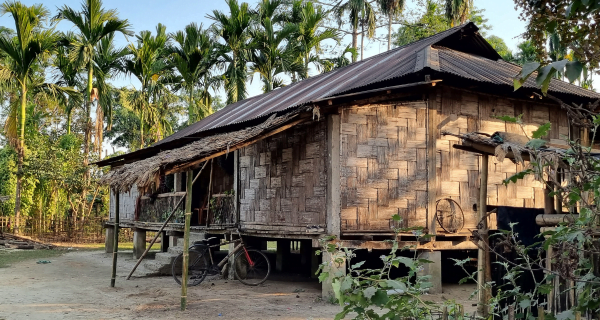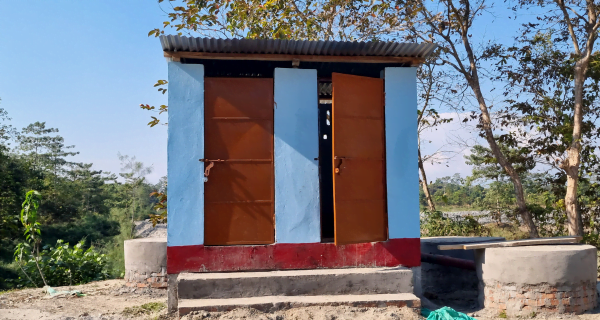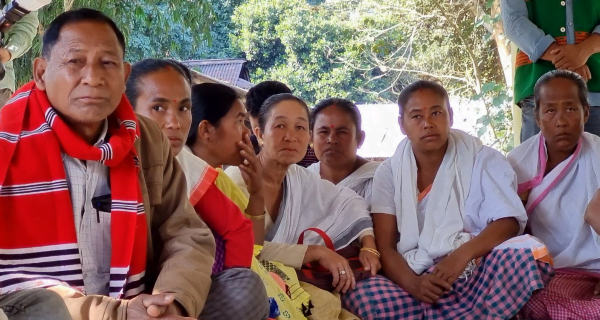By Tazeen Qureshy
For most of the days between May and September, Mitali Dole of Medhipamua village in Dhemaji district of Assam lives in uncertainty. Residing in one of the most flood-prone districts with a population of over 6.86 lakh (Census 2011), she is on alert day and night, gauging the water level in the Brahmaputra.
“We stock dry food and stay indoors. Once the water level or speed of flow increases, we shift to a safer place as our bamboo houses may collapse. In case of severe floods and widespread damage, we spend several weeks at the relief camp set up at a higher elevation,” she says.
According to the Council on Energy, Environment and Water 2021 report, Assam ranks first among the climate vulnerable states in India. Medhipamua is dominated by Mising tribals, also known as the ‘River People’ as they are believed to have migrated from Arunachal Pradesh to settle on the banks of the Brahmaputra. They reside in chang ghors or stilt houses, built mostly from bamboo at a height of six to eight ft.
With floods affecting livelihood opportunities, migration of men in search of work to southern states has increased. Often, women and children are left behind at home, which makes them a priority in building community-resilience mechanisms.
Though houses may remain dry during floods, sanitation is a challenge. The brick and mortar toilets are situated outside their homes at the ground level and get submerged when the floodwater arrives.
“In extreme situations, we women are forced to relieve ourselves at one corner of our houses as toilets become unusable. We try to take our boats to places that are dry and at a higher elevation, but that is not possible all the time,” admits Sunita Dole, whose house is barely 300 m from the riverbank.

“We always have this nagging fear that someone might see us attending to nature’s call. At night, we also feel insecure wading through the floodwaters in the dark,” she adds.
Her statement shows that though the state government has been setting up shelter homes/relief camps, providing services of midwives and operating anganwadis in relief camps, there is scope for more work.
Flood-only toilets
The sanitation woes prompted NGO Rural Volunteer Centre (RVC), which has worked extensively with flood-affected communities, to collaborate with UNICEF to offer a solution. After multiple delays during the COVID-19 period, two common concrete toilets and a tubewell were built with the help of villagers in Medhipamua by November last.
Located on a raised platform on an unused plot just across the road, it is barely a minute’s walk from the houses. Unless extremely necessary, these toilets should be used only during floods. For the rest of the time, people should use their individual toilets.
“We built this common utility as it is not possible to construct an elevated toilet for every house. The raised platform has enough room to accommodate 70 to 80 families when the village faces inundation,” says RVC director Luit Goswami.
The classes are held at a Child Friendly Space (CFS) that forms an important part of the flood relief camp in the locality. Launched in Dhemaji and Majuli districts as a pilot in 2017, the CFS has since become an integral part of the relief camp management process in the state. It operates as per the guidelines set by Assam State Disaster Management Authority and can serve as both anganwadi centres and other educational facilities.
“These toilets give us a sense of dignity. Women and adolescent girls feel embarrassed defecating outside. They are close to our homes, so we do not have to depend on anyone to reach there,” Mitali says.
With floods affecting livelihood opportunities, migration of men in search of work to southern states has increased. Often, women and children are left behind at home, which makes them a priority in building community-resilience mechanisms.
“In case of an emergency, the first responders are always the community. So, it is important to impart safety skills to them. Women and children need to be empowered to face any eventuality,” says RVC block coordinator Dharam Raj.
Child-friendly spaces
In Ajarbari village of Mukhtiyaar gram panchayat, Nitul Hajong, a college student, takes classes for flood-affected children. “Schools are shut for weeks or even a couple of months depending on the severity of floods. This hampers studies. To make things easy for primary school children, some of us conduct regular classes,” Hajong says.

The classes are held at a Child Friendly Space (CFS) that forms an important part of the flood relief camp in the locality. Launched in Dhemaji and Majuli districts as a pilot in 2017, the CFS has since become an integral part of the relief camp management process in the state. It operates as per the guidelines set by Assam State Disaster Management Authority and can serve as both anganwadi centres and other educational facilities.
Also Read: Rebuilding After COVID-19: Lessons From Recurring Crises Like Assam Floods & Amphan
The CFS helps children to tide over physical and psychosocial distress caused by floods. They are encouraged to learn coping strategies by socialising with others under adult supervision. “The idea is to provide a safe space, so that the trauma of frequent floods and disasters does not hamper the growth and learning opportunities of children. Here, health officials also take care of their nutritional needs,” says Goswami.
Sishu sabhas
In 2019, the State Institute of Panchayat and Rural Development, RVC and UNICEF collaborated in Bahir Jonai and Sille panchayats of Dhemaji to organise the first ever gaon sishu sabha, wherein children were asked to rake up the issues they face during disasters.
Sishu sabhas were proposed as an annual event to help children, who form one of the most vulnerable sections of the society. The event, to be held in schools in the presence of teachers and panchayat leaders, could not be organised in the subsequent years due to COVID-19 lockdown. The discussions right now are more about the problems they face and less solution-centric because the initial intention is to make them vocal.
Kalyum Doley, a student of the government high school in Lai-Mekuri, spoke about how technology can help in improving education. “We faced COVID-19 and we also deal with floods yearly. Our education is affected as classes remain shut for long. So, we (students) suggest a learning app that will help us study even if schools remain shut,” Doley makes her point clear.
A similar sabha was organised in December at Lai-Mekuri gram panchayat, where the students highlighted issues ranging from infrastructure to education before the panchayat officials.
Kalyum Doley, a student of the government high school in Lai-Mekuri, spoke about how technology can help in improving education. “We faced COVID-19 and we also deal with floods yearly. Our education is affected as classes remain shut for long. So, we (students) suggest a learning app that will help us study even if schools remain shut,” Doley makes her point clear.
“Drinking water is always an issue after floods. As students, we are taught that unclean water causes several diseases. We urge the elders to commit to clean water facilities all year round,” Munu Bodo, another student, was heard saying.

“Participation of children is of utmost importance to understand how they feel or react to a situation. We now plan to replicate Dhemaji’s sishu sabha model in other districts of Assam,” says Goswami.
Besides sishu sabha, school children in Dhemaji district are also participating in mock drills. In Bera Milan ME School in Rabha Kathani Malbhog, which has 134 students enrolled, one session every Saturday has been dedicated to disaster management and related teaching under the Saturday for Resilience Programme.
Also Read: Why Were Politicians Doing Power Gambling During Assam Floods?
“Living in a disaster-prone area, it is important that the students learn and understand the practical aspects of dealing with them. So, we conduct mock drills on safe evacuation during earthquakes twice a month. On other Saturdays, we discuss a disaster and impart basic knowledge on it to children,” says Jintu Kumar Gogoi, assistant teacher at the school.
Through all these initiatives, the government and other supporting agencies hope to make the next flood season a bit better for the people of Dhemaji.
About the author(s)
101Reporters is a pan-India network of grassroots reporters that brings out unheard stories from the hinterland.





